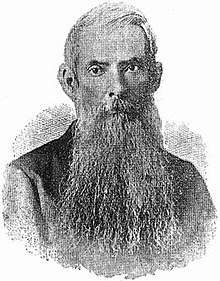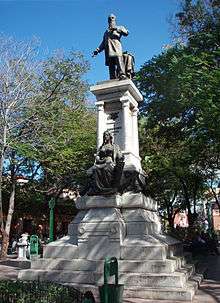Francisco Vicente Aguilera
Francisco Vicente Aguilera was a Cuban patriot born in Bayamo, Cuba on June 23, 1821.[1] He had ten children with his wife Ana Manuela Maria Dolores Sebastiana Kindelan y Sanchez. He studied at the University of Havana receiving the degree of Bachelor of Laws.[2]

Aguilera had inherited a fortune from his father, and in 1867 he was the richest landowner in the eastern region of Cuba, owning extensive properties, sugar refineries, livestock, and slaves. He never bought any of the slaves that were regularly brought from the African coast and offered for sale. He only used the slaves he had inherited from his father. This required him to hire many free workers to plant and harvest the sugarcane and work the farms. He was mayor of Bayamo, and he was a freemason and the head of the Masonic lodge in Bayamo.
He traveled to many countries, including the U.S., France, England, and Italy. On his travels he came into contact with governments that had chiefs of state who were not monarchs, leading him to embrace the progressive ideas to which he was exposed. He became an idealist who was always preoccupied with improving the conditions of his countrymen.
Insurrectionist
At the time, Spain remained in control of Cuba, but had lost control of several of its territories in Central and South America in the early 19th century. This was mostly due to the efforts of Simón Bolívar, who is credited with leading the fight for independence in what are now the countries of Venezuela, Colombia, Ecuador, Peru, Panama, and Bolivia. Colonial rule had its pros and cons. The pros being that the controlling country helped to improve the standard of living in the territory by building out infrastructure, introducing new technologies and implementing systems of governance and organization. The cons were that the controlling country exploited the people under their control with unfair labor practices and exploited the land with little or no recompense to the natives. In Cuba, the Spaniards were forcing the native Indians to work under dreadful conditions in gold mines. In Aguilera's lifetime, the cons were far outweighing the pros and he was very much in favor of the separation of Cuba from Spain.

In 1851, at the age of 30, Aguilera began to conspire against Spanish colonial rule, and joined himself with a movement begun by proto-independence patriot Joaquín de Agüero in Camagüey, Cuba. Henceforth, together with other wealthy landowners of the region, he spoke out openly against colonial Spanish rule. He led an anti-Spanish outbreak that occurred in Bayamo in 1867 and was selected as leader of a General Committee that had been designated to carry out plans for the insurrectionists. The other two members of this committee were Francisco Maceo and Pedro "Perucho" Figueredo, later author of the Cuban National Anthem. Aguilera actively participated in the creation of conspiratorial groups in diverse regions of the country, including the planning of preliminary reunions that culminated in the declaration of independence of October 10, 1868 at Yara, led by planter and lawyer Carlos Manuel de Cespedes. Aguilera took the position that Cespedes' revolt should wait until more money could be raised before attacking, and though his viewpoint did not prevail, he deferred total control of the insurrection and subsequent war to Cespedes, who became de facto leader of the independence movement. Aguilera's support of Cespedes stemmed from both his disinterest in political power, and his desire to improve the lot of his fellow countrymen.
Aguilera put his money where his mouth was. At one of the conspiracy meetings he famously announced that he was ready and willing to sell all his private property at market value to raise funds for arming the new Cuban Army of Independence. The following day, he published an ad in Bayamo's major newspaper offering all his properties, buildings, and livestock, which included 35,000 head of cattle and 4,000 horses, for sale.
Aguilera held many positions in the Cuban Army, including Major General, Minister of War, Vice President of the Republic, and Commander-in-Chief of the Eastern District. While in command of the army he was distinguished for courage and ability, taking part in person in many engagements and skirmishes.
Emancipation of slaves
Upon the outbreak of war in 1868, Aguilera freed all 500 of his slaves, an illegal action under the Spanish law in effect in Cuba at that time, and joined ranks with many of them to retake the city of Bayamo from the Spanish. Many of his ex-slaves became soldiers and officers in the War of Independence.
Death
In 1871, Francisco Vicente Aguilera went to New York City to raise funds for the war effort. He had given everything away for the cause of Cuban independence. Aguilera died completely destitute after a brief bout with throat cancer in his apartment at 223 West 30th Street in New York on February 22, 1877. The Cuban Republic, finally free after so many years and casualties, honored Aguilera by printing his image on the Cuban $100 peso bill (pictured above) that was in circulation prior to the 1959 communist revolution.
References
- "Francisco Vicente Aguilera". New York Times. 1877-02-24.
_100_silver_pesos%2C_1936_(CUB-74b).jpg)